I earn commissions from my affiliated links. Please see my disclosure policy for more details.
Are you looking for simple, yet fascinating science experiments that your kids can do at home? Why not explore the topic of surface tension with some fun activities and experiments? Surface tension is an interesting phenomenon that captures the imagination of even young children.
With just a few materials, they will be able to conduct hands-on experiments to observe and understand surface tension in action.
In this post, we’ll talk about what surface tension is, provide examples of relevant everyday objects as well, and explain four engaging experiments you and your kids or students can try out today! Let’s get started!
Surface Tension Experiments for Kids
As you can probably guess from all my science-related posts lately, my sons are a bit, shall we say, obsessed with science experiments right now. For example, we love the dancing milk experiment and love doing experiments with try ice!
So, I grabbed one of my trusty resources, 101 Great Science Experiments, and searched for an easy and inexpensive activity. Sure enough, I landed on perhaps the most perfect surface tension science experiment for kids.
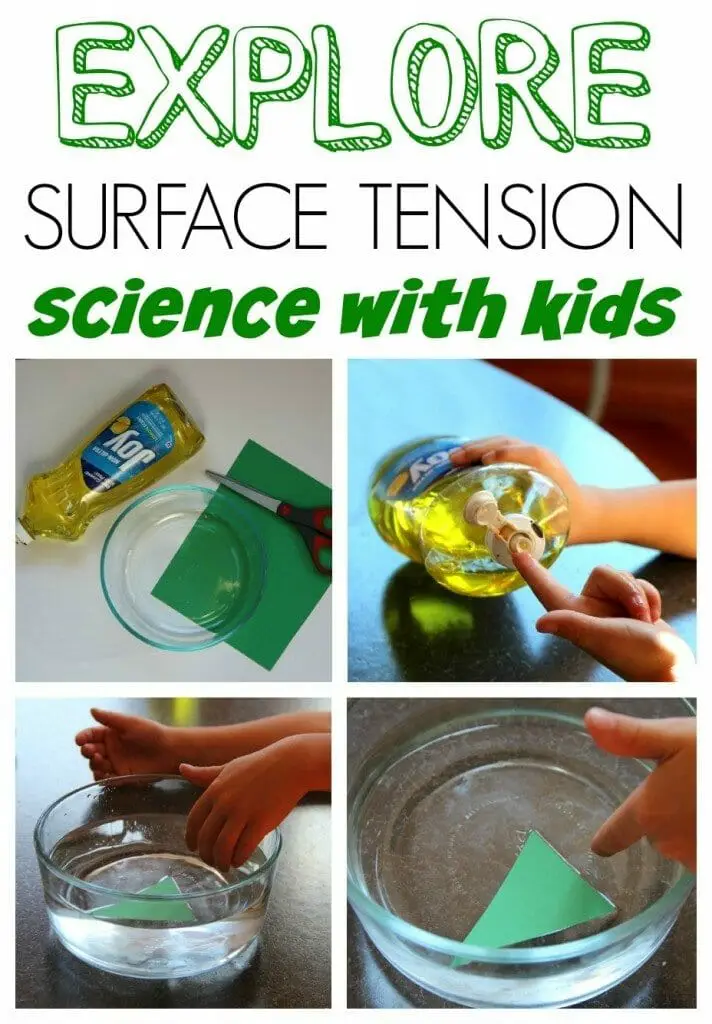
What are 5 examples of surface tension?
Surface tension is the property of a liquid that allows it to resist external forces that could increase its surface area. Here are five examples of surface tension in action:
- Water Striders: Water striders are insects that can walk on the surface of water due to the surface tension of water. Their legs do not break through the surface because of the cohesive forces between water molecules.
- Capillary Action: Surface tension is responsible for capillary action, where liquids can rise or fall in narrow tubes or porous materials against the force of gravity. This phenomenon is seen in plants’ ability to draw water from the soil into their roots.
- Droplets Forming on Leaves: When you see water droplets forming on the surface of leaves or other hydrophobic (water-repellent) surfaces, it’s due to surface tension. The cohesive forces of water cause it to bead up rather than spread out.
- Soap Bubbles: Soap bubbles are held together by surface tension. The soap molecules in the bubble’s film reduce surface tension, allowing the bubble to form and hold its shape.
- Droplets on a Needle: When you touch the surface of water with a fine needle, it can cause water to form a droplet at the tip of the needle. This is due to the surface tension of water trying to minimize its surface area.
Surface tension plays a significant role in various natural phenomena and everyday experiences, as demonstrated by these examples.
Surface Tension Science Experiment for Kids
Science is hands-on and fun for kids. The great part is that kids learn something while doing experiments that they enjoy! With a little bit of knowledge, you can easily bring this learning into your home and classroom.
Surface tension experiments can be both fun and educational for kids. These experiments help children understand the concept of surface tension, which is the property of the surface of a liquid that allows it to resist an external force due to the cohesive nature of its molecules.
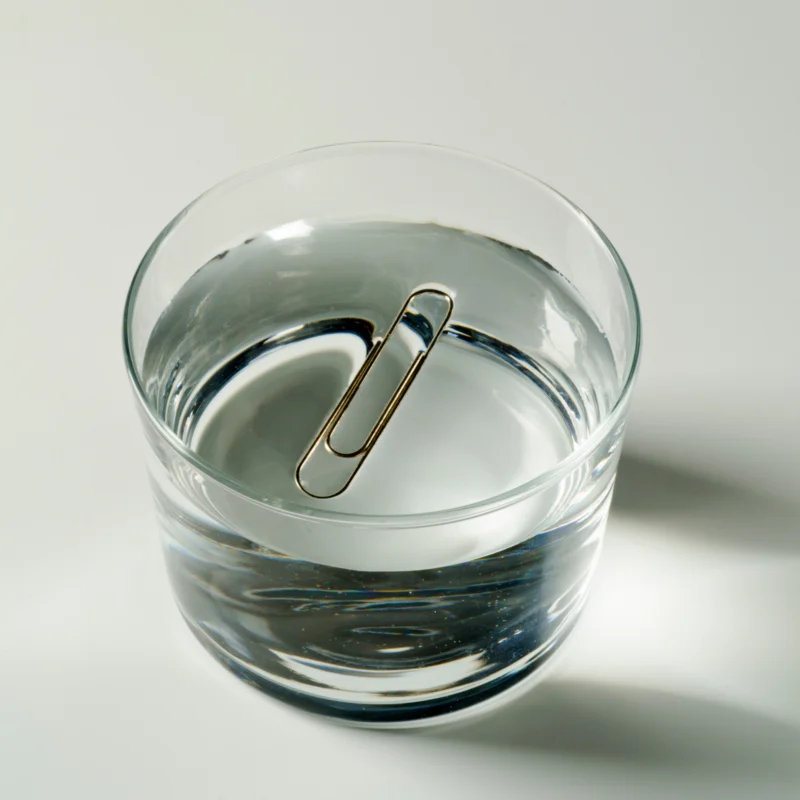
Surface Tension Science Activities
#1 – Floating Paper Clip
You’ll need a bowl of water, a paper clip, and a tissue or small piece of aluminum foil. Kids can place the paperclip gently on the surface of the water. They’ll observe how the water’s surface tension allows the paperclip to float.
#2 – Magic Milk
For this experiment, you’ll need a shallow dish, milk, food coloring, and liquid dish soap. Pour a small amount of milk into the dish, add a few drops of different food coloring, and then add a drop of dish soap in the center. Kids will be amazed as they watch the colors race to the edges of the dish due to changes in surface tension.
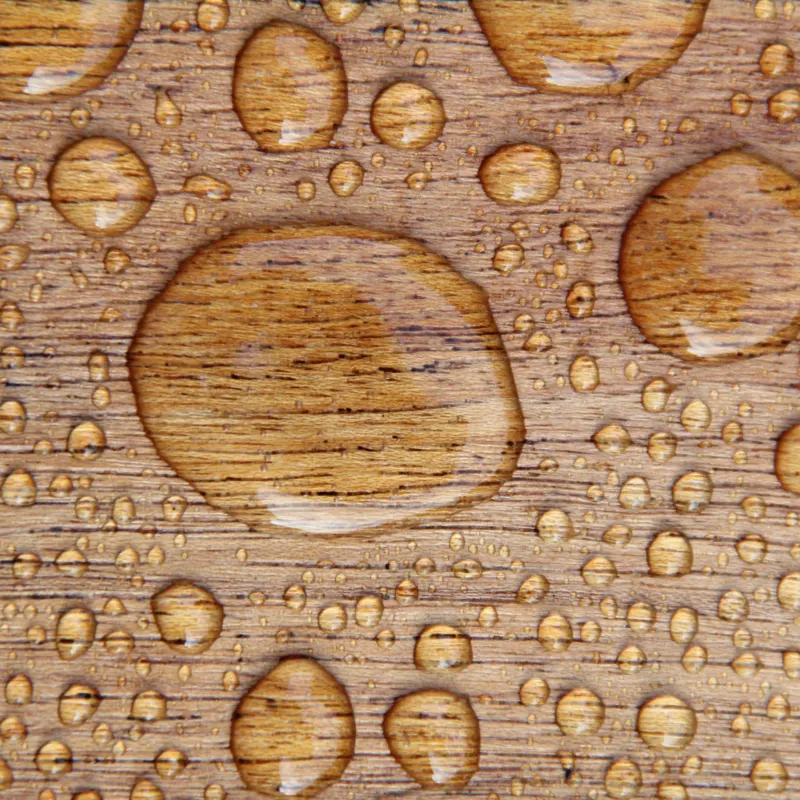
#3 – Floating Needle
Gather a bowl of water and a sewing needle. Slowly and carefully place the needle on the surface of the water. Kids will see that the needle can float on the surface due to surface tension.
#4 – Soap Boat
This experiment requires a small piece of aluminum foil, a bowl of water, and a bar of soap. Kids can cut the aluminum foil into the shape of a small boat and place it in the water. Then, they can carefully touch the soap to the water near the boat, and they’ll observe how the boat moves due to changes in surface tension.
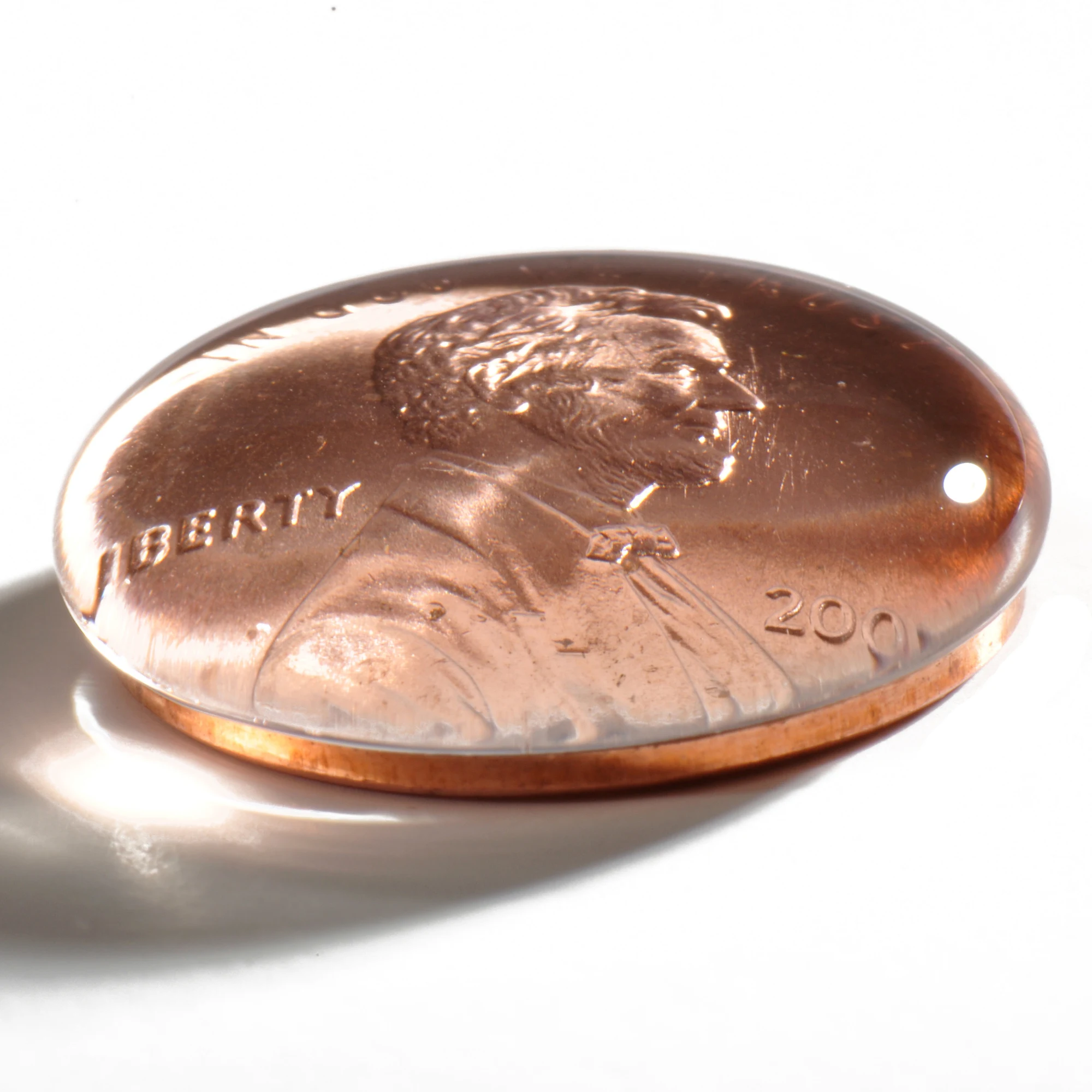
#5 – Water Droplets on a Coin
Kids can place a clean, dry coin on a flat surface and carefully add water droplets one at a time using a dropper. They’ll notice how the water forms droplets and doesn’t immediately spread out due to surface tension.
#6 – Soap Bubbles
Making soap bubbles is a classic surface tension experiment. You’ll need a solution of water and dish soap and a bubble wand or straw. Kids can dip the wand or straw into the solution and gently blow it to create bubbles. They’ll learn how surface tension creates the thin film of the bubble.
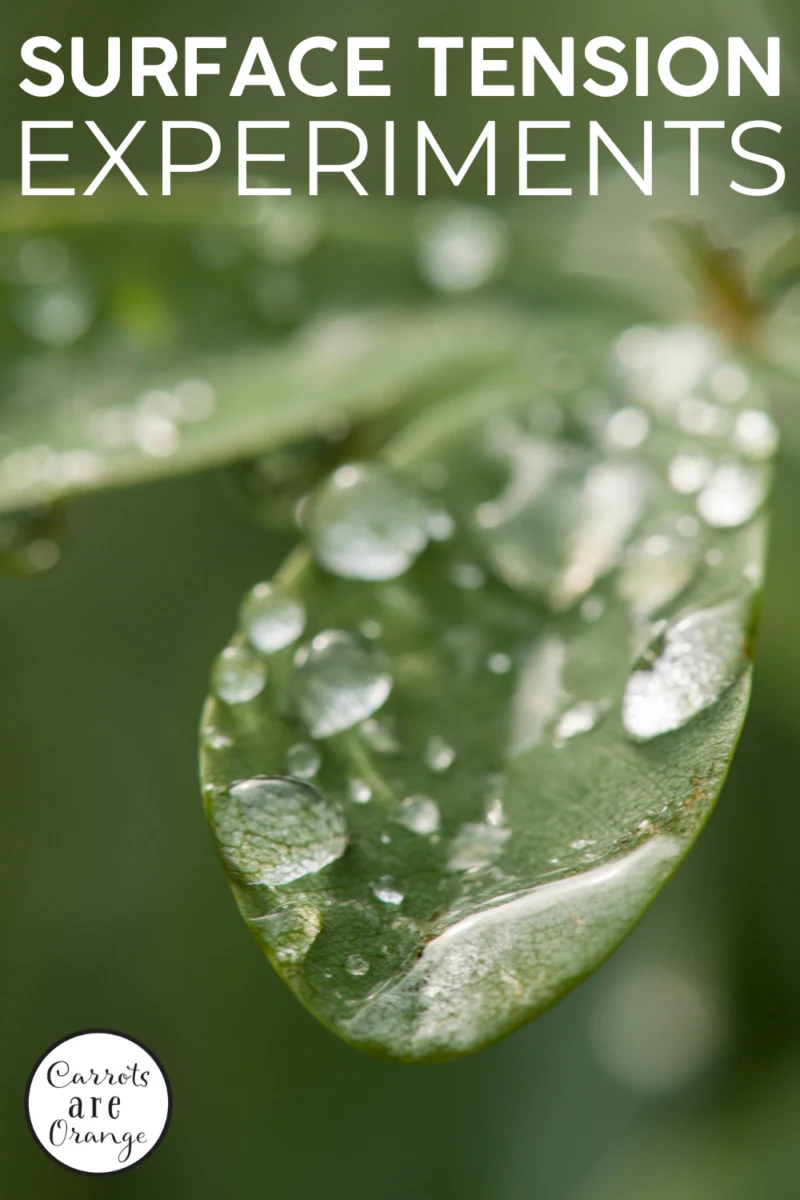
#7 – Floating Pepper
Fill a bowl with water and sprinkle a small amount of pepper on the surface. Kids can then dip their finger, which has a tiny bit of liquid dish soap on it, into the water near the pepper. They’ll observe the pepper moving away from the soap as the surface tension is disrupted.
#8 – Water Bridge
Place two identical cups close together on a flat surface and fill them with water. Use a straw to create a bridge between the two cups by carefully touching the surface of the water in each cup. Kids will see a water bridge forming due to surface tension.
Remember to always supervise kids during these experiments, especially when handling small objects and liquids, and ensure they understand the safety precautions involved. These experiments can help children learn about the properties of water and surface tension in an engaging and hands-on way.
Easy Surface Tension Experiment with Dish Soap
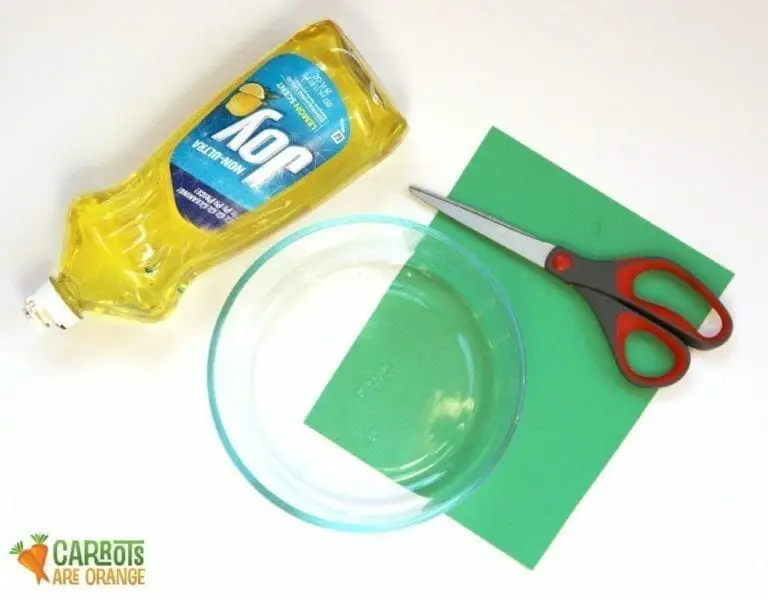
Materials
- Scissors
- Card stock
- Bowl*
- Water
- Dish soap
* I used a circular bowl first, then we used a longer Pyrex bowl, which worked better because there was more space for the boat to speed off

Approach
- Cut a triangle from the card stock for your “boat”
- Fill your bowl with water*
- Gently place the triangle on top of the water (introduce the concept of surface tension)
- Place a small amount of dish soap on a finger
- Dip the fingertip into the water behind the “boat”
- Observe the boat speed off
- Encourage and ask questions
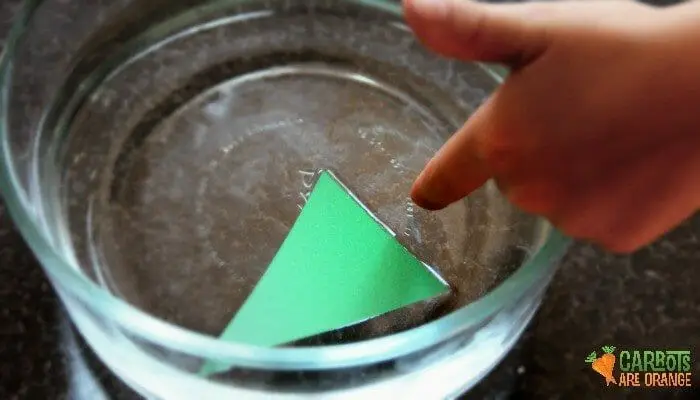
What is the Science Behind Surface Tension?
Surface tension is a fascinating phenomenon in fluid dynamics that arises due to the cohesive forces between the molecules of a liquid. It’s responsible for several interesting behaviors and effects, such as the ability of small insects to walk on water, the formation of droplets, and the shape of liquid surfaces.
Here’s a brief overview of the science behind surface tension:
- Molecular Cohesion: Surface tension is primarily a result of the cohesive forces between liquid molecules. These forces are primarily caused by intermolecular interactions, such as van der Waals forces and hydrogen bonding, depending on the nature of the liquid. These forces cause molecules at the surface of the liquid to be attracted to their neighboring molecules beneath the surface.
- Unequal Forces: Molecules inside the liquid experience cohesive forces from all directions because they are surrounded by other liquid molecules. However, molecules at the surface do not have molecules above them to balance the cohesive forces. This imbalance in forces results in a net inward force, which acts to minimize the surface area of the liquid.
- Energy Minimization: Nature tends to minimize the energy of a system. In the case of a liquid, minimizing the surface area minimizes the energy associated with the surface. As a result, liquids naturally form shapes that minimize their surface area, which is usually a sphere for small droplets or a flat surface for larger bodies of liquid.
- Mathematical Expression: Surface tension is quantified by a physical property called surface tension coefficient (symbolized as σ), which is measured in units of force per unit length (e.g., N/m or dyn/cm). It represents the amount of force required to increase the length of a liquid interface by a unit amount. The higher the surface tension, the more difficult it is to increase the surface area of the liquid.
- Effects of Surface Tension: Surface tension is responsible for various everyday phenomena, such as the formation of water droplets, capillary action (the rise of liquids in narrow tubes), the ability of small objects to float on the surface of water, and the shape of liquid menisci in narrow containers.
- Contact Angle: When a liquid wets a solid surface, the angle at which the liquid meets the solid is called the contact angle. The contact angle is determined by the balance between adhesive forces (liquid-solid interaction) and cohesive forces (liquid-liquid interaction) and is influenced by surface tension.
- Surfactants: Substances known as surfactants (surface-active agents) can reduce surface tension by interfering with the cohesive forces between liquid molecules. Surfactants are commonly used in detergents and soaps to help break up and remove dirt and grease from surfaces.
Surface tension is a result of the attractive forces between liquid molecules, which causes the surface of a liquid to behave like a stretched elastic membrane. It plays a crucial role in many natural and industrial processes and is a fundamental concept in fluid mechanics.
Other Surface Tension Experiment Ideas
- Experiment with different substances in the water (black pepper, for example, gives a great demonstration of soap deterring germs
- Explain how the dish soap weakens the surface tension of the water. So, the tension is stronger in front of the “boat”.
- Use different liquids
- Utilize different shapes (talk about velocity and physics)
- What happens with more dish soap? More water? A bigger “boat”?
- Have “boat” races
- Experiment with different objects to see if the water’s surface tension can support various objects (such as a paper clip)
- Sink/Float work
